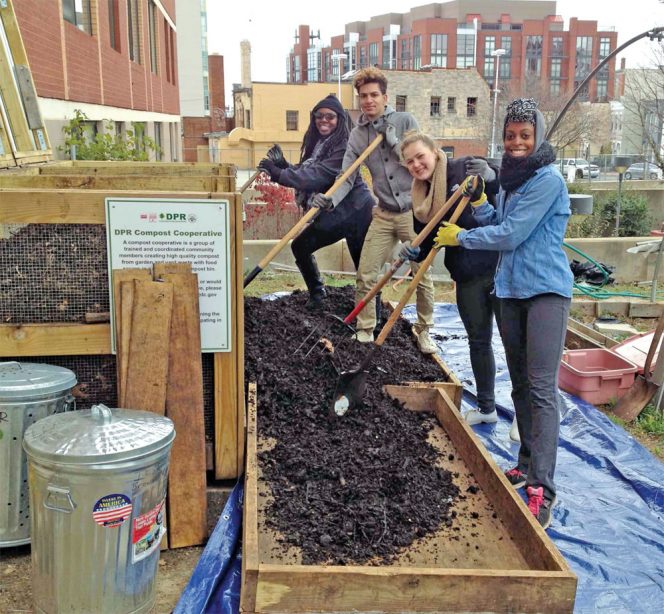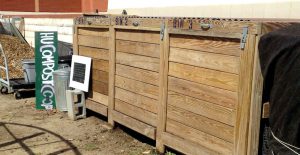A recently released feasibility study analyzed options for recycling the District of Columbia’s food scraps and yard trimmings.
Marsha Johnston and Craig Coker
BioCycle August 2017

Approximately 60 tons/year of food scraps are composted through the D.C. Parks & Recreation Department’s (DPR) Community Compost Cooperative Network. Photo by Jeffrey Neal, DC DPR Compost Cooperative at Howard University
Currently, the District is composting between 5,000 and 7,000 tons of leaves collected during leaf pick-up season, along with Christmas trees. In addition, approximately 60 tons/year of food scraps and garden debris are composted at community gardens under the District’s Parks and Recreation Department’s (DPR) Community Compost Cooperative Network. In 2016, there were 41 community gardens in the District with composting bins. Fifty bins should be in place and operating by the end of 2017.
While demand for composting exists in the DC metropolitan area, regional organics recovery infrastructure has not grown proportionately. Only two facilities that accept both food scraps and yard trimmings are within 40 miles of the District. While the DPW may be able to work out an agreement with these or other smaller facilities in the region to accept its source separated organics (SSO), projected transfer costs are $37/ton or more. Resource Recycling Systems (RRS), which conducted the feasibility study, found it would be economically disadvantageous to transfer organics collected in the District. Direct hauling of the SSO to a processing facility within the District was the consultant’s preferred recommendation. By avoiding transfer costs and collecting a tipping fee, RRS estimated that $12.35 million in potential capital would be freed up to build an in-District composting facility.

Three-bin food scraps composting system at the DPR’s Compost Cooperative at Howard University. Photo by Jeffrey Neal, DC DPR Compost Cooperative at Howard University
Five-Year Plan
The feasibility study prescribed a 5-year plan to roll out a food scraps and yard trimmings curbside collection program to District residents who are serviced by the DPW. Facility construction would begin in Year 2. “We are commencing now with many of the preparatory activities recommended for Year 1, including updating existing food waste disposal recommendations,” explains Annie White, Manager of the DPW’s Office of Waste Diversion. “The study recommends that we don’t launch residential curbside collection until we have a long-term infrastructure plan in place.And it’s clear in pointing out that we do not have the existing capacity now.”
The DC City Council allocated $8 million for a 10- to 20-acre composting facility in its 2023 capital expenditures. “To accommodate the FY 2023 date for capital funding, then Year 2 would be FY 2023,” notes White. She adds that the $8 million is within the $7 million to $12 million range cited in the feasibility study, which concluded that construction of a covered, aerated static pile facility should begin in Year 2 and aim for completion by the fall of Year 3.
The District would “strongly” consider the composting technology recommendation due to its favorable performance and cost for the slightly higher yard trimmings-to-food scraps ratio generated by the District’s residential sector, notes White. “We also would look at options such as codigestion for the commercial sector, which generates 114,000 tons/year of food waste. DPW is preparing to undertake a codigestion study, which should be completed in FY18.”
Once the composting facility is under construction, the report recommends rolling out curbside SSO collection to a third of the District’s residential customers. Those organics would be trucked to several composting facilities in northern Virginia. To facilitate that phase, explains White, the District will have to approve “some more pieces” of the full organics recycling rollout.
In the meantime, the District will continue its existing organics recycling initiatives that include DPR’s community composting initiative; the DPW’s Food Waste Drop-Off Program in each of the District’s eight wards; cafeteria composting in 60 schools; a grass cycling campaign; and updating food waste regulations identified in the study to encourage composting. “I’m excited about opportunities for composting in the District,” notes White. “We are seeing a lot of support.”
Marsha Johnston is a Contributing Editor and Craig Coker is Senior Editor of BioCycle.










